 |
| ||
 |
|||
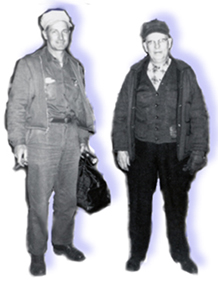  Pennsylvania Railroad Pennsylvania Railroad Vandalia Railroad Vandalia Railroad Nickel Plate Road Nickel Plate Road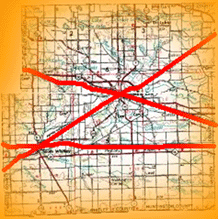
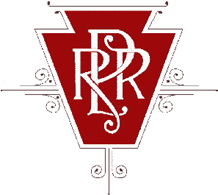 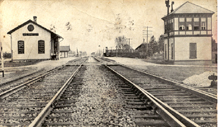 Pennsylvania line through Arcola, Indiana.  Pennsylvania Railroad Pennsylvania Railroad Vandalia Railroad Vandalia Railroad Nickel Plate Road Nickel Plate Road Back to Top Back to Top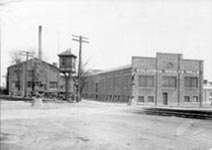
Vandalia crossing Main Street in Columbia City, Indiana. Click it! ACPL photo  Wooden trestle of Vandalia Railroad in South Whitley, Indiana.  Pennsylvania Railroad Pennsylvania Railroad Vandalia Railroad Vandalia Railroad Nickel Plate Road Nickel Plate Road Back to Top Back to Top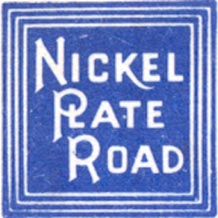 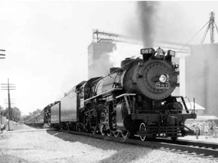 NKP 2-8-2 #587 and 2-8-4 #765 in So. Whitley, IN, 1993. 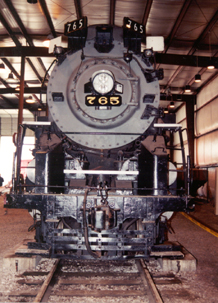 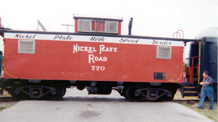 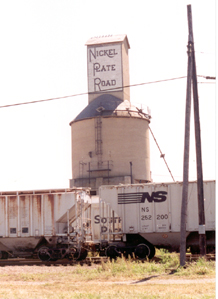  Pennsylvania Railroad Pennsylvania Railroad Vandalia Railroad Vandalia Railroad Nickel Plate Road Nickel Plate Road Back to Top Back to Top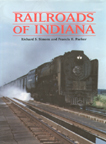  |
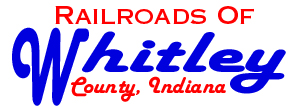  Railroads played major roles in communities of the late nineteenth and early twentieth centuries. They brought news, goods, friends and family, and took away as much. They were often heavily tied to local industry
as well as being major employers for many towns along the way. The railroads also provided a unique look to the area. Dotted track-side every few miles were depots, track service buildings, signaling equipment, battery boxes, relay cabinets, water towers, and, in some locations, coaling towers. Railroads played major roles in communities of the late nineteenth and early twentieth centuries. They brought news, goods, friends and family, and took away as much. They were often heavily tied to local industry
as well as being major employers for many towns along the way. The railroads also provided a unique look to the area. Dotted track-side every few miles were depots, track service buildings, signaling equipment, battery boxes, relay cabinets, water towers, and, in some locations, coaling towers.
 Whitley County was no different. Serviced by no less than three railroads, it would be hard not to notice the impact of such major forces on the community. Two east-west lines running from Fort Wayne and points east from Chicago and the western connections. And one line that ran from the southwest corner
of the county on through to the northeast corner. While the times have changed, the railroads still work hard through Whitley County but with much less impact. Whitley County was no different. Serviced by no less than three railroads, it would be hard not to notice the impact of such major forces on the community. Two east-west lines running from Fort Wayne and points east from Chicago and the western connections. And one line that ran from the southwest corner
of the county on through to the northeast corner. While the times have changed, the railroads still work hard through Whitley County but with much less impact. What follows is a railroad by railroad overview from tracklaying to present. The railroads are in the order that they appeared in Whitley County. (Place your pointer on one of the highlighted map lines to see which railroad it is.) What follows is a railroad by railroad overview from tracklaying to present. The railroads are in the order that they appeared in Whitley County. (Place your pointer on one of the highlighted map lines to see which railroad it is.)
Pennsylvania Railroad The Pennsylvania's 468-mile Chicago main line originally started out as three separate companies. Following financial difficulties, the three merged to form the Pittsburgh, Fort Wayne, and Chicago in 1856. With assistance from the Pennsylvania, the PFW&C reached Chicago in 1858 and became the Pennsylvania's main
road to Chicago. Double tracked, the 153 miles of Indiana route pierced Whitley County in the east and exited on the west passing through Coesse, Columbia City and Larwill. This racetrack of the "Standard Railroad of the World" played host to many famous trains such as the Broadway Limited. The Pennsylvania's 468-mile Chicago main line originally started out as three separate companies. Following financial difficulties, the three merged to form the Pittsburgh, Fort Wayne, and Chicago in 1856. With assistance from the Pennsylvania, the PFW&C reached Chicago in 1858 and became the Pennsylvania's main
road to Chicago. Double tracked, the 153 miles of Indiana route pierced Whitley County in the east and exited on the west passing through Coesse, Columbia City and Larwill. This racetrack of the "Standard Railroad of the World" played host to many famous trains such as the Broadway Limited.  The term "Broadway" had nothing to do with New York, where the train originated, but more to do with the great width of the Pennsylvania's four wide main tracks. In Columbia City, the railroad was indeed four tracks wide (two mains and two passing tracks) between Line Street and Wolfe Road. This, too, is where
the Penn crossed over the Vandalia at grade. The tower controlled this crossing. The tower was a two-story structure that controlled the switches and signaling for the area and determined which train had the right of way. The term "Broadway" had nothing to do with New York, where the train originated, but more to do with the great width of the Pennsylvania's four wide main tracks. In Columbia City, the railroad was indeed four tracks wide (two mains and two passing tracks) between Line Street and Wolfe Road. This, too, is where
the Penn crossed over the Vandalia at grade. The tower controlled this crossing. The tower was a two-story structure that controlled the switches and signaling for the area and determined which train had the right of way. The Pennsylvania hosted 32 daily passenger trains at peak and countless freight in addition to many one-of-a-kind locomotive designs. Gradually, the world began to change and maintaining the bottom line ever more difficult. In an ill-fated attempt to preserve dominance, the Pennsylvania merged with bitter rival New York Central in 1968. The Pennsylvania hosted 32 daily passenger trains at peak and countless freight in addition to many one-of-a-kind locomotive designs. Gradually, the world began to change and maintaining the bottom line ever more difficult. In an ill-fated attempt to preserve dominance, the Pennsylvania merged with bitter rival New York Central in 1968. Doomed from the beginning, the merged road was plagued with computer problems, differences in management styles, and pure disdain for one-another. The mega-system, PennCentral, filed for bankruptcy in June, 1970, just two years after the merger. This stunning bankruptcy and the foreseeable failure of many more led to the creation of Conrail. The Regional Rail Act of 1973
allowed the newly formed Conrail to absorb and shed lines like never before allowing for a streamlined efficient rail network. Doomed from the beginning, the merged road was plagued with computer problems, differences in management styles, and pure disdain for one-another. The mega-system, PennCentral, filed for bankruptcy in June, 1970, just two years after the merger. This stunning bankruptcy and the foreseeable failure of many more led to the creation of Conrail. The Regional Rail Act of 1973
allowed the newly formed Conrail to absorb and shed lines like never before allowing for a streamlined efficient rail network. Conrail, being made of many failed railroads, had tremendous redundancy that it quickly parted with thanks to the railroad deregulation Staggers Act of 1980. Preferring the northern NYC line through Elkhart, Indiana, Conrail placed the Pennsylvania line through Whitley county as a secondary route ripping out the second main line. This left only one main track with minimal signaling. A mere skeleton of it's former glory.
In an attempt to preserve American passenger train service, Amtrak was formed to take over routes and in 1971 began running trains across the Pennsylvania line until 1990. Deferred maintenance and general neglect made it a costly dilapidated property for Conrail and in 1994-5 Norfolk Southern bought the line as a relief outlet for it's busier line to the south. In the early 1990s, Norfolk Southern and Conrail entered into talks about a buyout. Another eastern rail giant, CSX, made it known that it, too, was interested in Conrail, which was by then a lean profit machine. On June 1, 2000, CSX and Norfolk Southern took control
of Conrail together splitting the assets between themselves. In the final design, Norfolk Southern gave up the Pennsylvania route through Whitley County to CSX while taking over the Elkhart line to the north. Conrail, being made of many failed railroads, had tremendous redundancy that it quickly parted with thanks to the railroad deregulation Staggers Act of 1980. Preferring the northern NYC line through Elkhart, Indiana, Conrail placed the Pennsylvania line through Whitley county as a secondary route ripping out the second main line. This left only one main track with minimal signaling. A mere skeleton of it's former glory.
In an attempt to preserve American passenger train service, Amtrak was formed to take over routes and in 1971 began running trains across the Pennsylvania line until 1990. Deferred maintenance and general neglect made it a costly dilapidated property for Conrail and in 1994-5 Norfolk Southern bought the line as a relief outlet for it's busier line to the south. In the early 1990s, Norfolk Southern and Conrail entered into talks about a buyout. Another eastern rail giant, CSX, made it known that it, too, was interested in Conrail, which was by then a lean profit machine. On June 1, 2000, CSX and Norfolk Southern took control
of Conrail together splitting the assets between themselves. In the final design, Norfolk Southern gave up the Pennsylvania route through Whitley County to CSX while taking over the Elkhart line to the north. What was once a mighty giant is now a barely used reminder and occasional nuisance to those living near it. A presence for nearly 150 years, it's future is more uncertain now than ever. But there is hope for renewed traffic and that lies with the new building of line-side industry. But that is another battle all it's own. What was once a mighty giant is now a barely used reminder and occasional nuisance to those living near it. A presence for nearly 150 years, it's future is more uncertain now than ever. But there is hope for renewed traffic and that lies with the new building of line-side industry. But that is another battle all it's own.
Vandalia Railroad Completed in 1874 as the Detroit, Eel River and Illinois, this line was a 93-mile outlet for farmers. Looking for better crop prices, the line was built from Logansport, Indiana, to Butler, Indiana, crossing Whitley County from the southwest to the northeast. The line passed through Collamer, South Whitley, across the Pennsylvania at Columbia City, and on through Churubusco. Completed in 1874 as the Detroit, Eel River and Illinois, this line was a 93-mile outlet for farmers. Looking for better crop prices, the line was built from Logansport, Indiana, to Butler, Indiana, crossing Whitley County from the southwest to the northeast. The line passed through Collamer, South Whitley, across the Pennsylvania at Columbia City, and on through Churubusco.  The railroad entered into a lease agreement with the Wabash Railroad in 1879 for a period of 99 years. The Wabash was building a railroad to take on the eastern giants and the availability of the Eel River line provided the missing link. In an effort to smooth movements, the Wabash abandoned the shop facilities in Logansport in favor of their own in Peru, Indiana. The bondholders were outraged and began a cat and mouse legal battle with the Wabash trying to annul the lease agreement. After 10 years of legal fighting, the bondholders again had control of their railroad. The railroad entered into a lease agreement with the Wabash Railroad in 1879 for a period of 99 years. The Wabash was building a railroad to take on the eastern giants and the availability of the Eel River line provided the missing link. In an effort to smooth movements, the Wabash abandoned the shop facilities in Logansport in favor of their own in Peru, Indiana. The bondholders were outraged and began a cat and mouse legal battle with the Wabash trying to annul the lease agreement. After 10 years of legal fighting, the bondholders again had control of their railroad. The road, once an integral part of a major railroad was now an expensive piece of unprofitable property. Quickly the Detroit, Eel River and Illinois railroad was sold to the Pennsylvania Railroad in 1901 and folded into the Pennsy's Vandalia holdings. It was now known as the Vandalia Railroad. The road, once an integral part of a major railroad was now an expensive piece of unprofitable property. Quickly the Detroit, Eel River and Illinois railroad was sold to the Pennsylvania Railroad in 1901 and folded into the Pennsy's Vandalia holdings. It was now known as the Vandalia Railroad.  The Vandalia never amounted to much. Traffic diminished over the years and abandonment came piece by piece beginning in 1954 and ending in 1977 with the last section. This last section ran to the southwest through South Whitley from Columbia City's connection with the Pennsylvania Railroad. The Vandalia never amounted to much. Traffic diminished over the years and abandonment came piece by piece beginning in 1954 and ending in 1977 with the last section. This last section ran to the southwest through South Whitley from Columbia City's connection with the Pennsylvania Railroad.  Today, precious few reminders of the Vandailia exist. In Collamer, only the bridge piers exist and exiting South Whitley remains a wooden trestle. A fantastic example of early railroading. And in Columbia City, a small relay box and line pole stands at the crossing site on Main Street. A few other buildings with distinct railroad heritage still exist in Collins and Churubusco as well as a very prominent grade that parallels Indiana State Road 205 to the north east of Columbia City. Today, precious few reminders of the Vandailia exist. In Collamer, only the bridge piers exist and exiting South Whitley remains a wooden trestle. A fantastic example of early railroading. And in Columbia City, a small relay box and line pole stands at the crossing site on Main Street. A few other buildings with distinct railroad heritage still exist in Collins and Churubusco as well as a very prominent grade that parallels Indiana State Road 205 to the north east of Columbia City.Nickel Plate Road Opened in 1882, the New York, Chicago and St. Louis Railroad, better known as the Nickel Plate Road, ran between Buffalo, New York, and Chicago, Illinois. In Whitley county, it ran through Dunfee, Raber, Peabody, and South Whitley where it crossed the Vandalia. Built on speculation, the line was redundant in every sense of the word. Already, there were several New York to Chicago lines and quickly it was sold to run under control of the New York Central. In 1916, the government forced the sale of the Nickel Plate and in 1923 the road acquired the Lake Erie and Western Railroad and the Toledo, St. Louis and Western (Clover Leaf) Railroad in Indiana. Opened in 1882, the New York, Chicago and St. Louis Railroad, better known as the Nickel Plate Road, ran between Buffalo, New York, and Chicago, Illinois. In Whitley county, it ran through Dunfee, Raber, Peabody, and South Whitley where it crossed the Vandalia. Built on speculation, the line was redundant in every sense of the word. Already, there were several New York to Chicago lines and quickly it was sold to run under control of the New York Central. In 1916, the government forced the sale of the Nickel Plate and in 1923 the road acquired the Lake Erie and Western Railroad and the Toledo, St. Louis and Western (Clover Leaf) Railroad in Indiana. The Nickel Plate became a lean, well-oiled machine setting the pace with its "million dollar" fast dressed meat freights. The road quickly showed the larger competing railroads that they were indeed a force to reckon with and established the industry known and shipper valued slogan of Nickel Plate High Speed Service. Passenger service was offered but the Nickel Plate chose to focus on a relaxed time schedule rather than compete with the ultra quick timetables of the larger roads. Merchandise was the real bread and butter of the Nickel Plate and that is where they poured their energy. The Nickel Plate became a lean, well-oiled machine setting the pace with its "million dollar" fast dressed meat freights. The road quickly showed the larger competing railroads that they were indeed a force to reckon with and established the industry known and shipper valued slogan of Nickel Plate High Speed Service. Passenger service was offered but the Nickel Plate chose to focus on a relaxed time schedule rather than compete with the ultra quick timetables of the larger roads. Merchandise was the real bread and butter of the Nickel Plate and that is where they poured their energy. Late to dieselize, the Nickel Plate was well known for their extraordinary 2-8-4 Berkshire type steam locomotives. Built by Lima Locomotive of Lima, Ohio, they were superb performers. The first of the famous Lima Super Power design, these engines were able to continually build horsepower even as speed increased. Today, the Fort Wayne Railroad Historical Society has preserved Berkshire #765 for operations and is a shining example of the Super Power concept. The NKP bought its last steam locomotive and Lima's last built steamer, Berkshire #779, in 1949 (currently preserved in Lima, OH.) They had stuck with steam long after most railroads had begun serious dieselization. Late to dieselize, the Nickel Plate was well known for their extraordinary 2-8-4 Berkshire type steam locomotives. Built by Lima Locomotive of Lima, Ohio, they were superb performers. The first of the famous Lima Super Power design, these engines were able to continually build horsepower even as speed increased. Today, the Fort Wayne Railroad Historical Society has preserved Berkshire #765 for operations and is a shining example of the Super Power concept. The NKP bought its last steam locomotive and Lima's last built steamer, Berkshire #779, in 1949 (currently preserved in Lima, OH.) They had stuck with steam long after most railroads had begun serious dieselization. The end for the Nickel Plate came on October 16, 1964, when the Norfolk and Western merged with the Nickel Plate. The surviving corporation, the Norfolk and Western, also leased the Wabash Railroad at this time and ended that length of corporate history as well. Then, on June 1, 1982, the Norfolk and Western along with Southern Railway formed the Norfolk Southern Corporation. While old Nickel Plate mileage was shed elsewhere in Indiana, the main line through Whitley County continued on as busy as ever. Norfolk Southern then, in 1994-5, acquired the Pennsylvania line through Whitley County as relief for its Nickel Plate main. And finally in 2000, with CSX Transportation, acquired Conrail. In the midst of sorting out which railroad got which Conrail lines, it was decided that NS would keep the NKP main and the Penn line would again change hands and go to CSX. The end for the Nickel Plate came on October 16, 1964, when the Norfolk and Western merged with the Nickel Plate. The surviving corporation, the Norfolk and Western, also leased the Wabash Railroad at this time and ended that length of corporate history as well. Then, on June 1, 1982, the Norfolk and Western along with Southern Railway formed the Norfolk Southern Corporation. While old Nickel Plate mileage was shed elsewhere in Indiana, the main line through Whitley County continued on as busy as ever. Norfolk Southern then, in 1994-5, acquired the Pennsylvania line through Whitley County as relief for its Nickel Plate main. And finally in 2000, with CSX Transportation, acquired Conrail. In the midst of sorting out which railroad got which Conrail lines, it was decided that NS would keep the NKP main and the Penn line would again change hands and go to CSX. For now, the future of the NKP main looks good but as economic tides change so too do the importance of rail lines. The Nickel Plate lives on with preserved equipment of various types. The links section of this page will point you to various historical and preservation groups for even more history and detail. For now, the future of the NKP main looks good but as economic tides change so too do the importance of rail lines. The Nickel Plate lives on with preserved equipment of various types. The links section of this page will point you to various historical and preservation groups for even more history and detail.Conclusion The face of railroading in Whitley County has changed greatly over the years and the direct impact and importance to the county has as well. We can only hope that in future years the remaining railroads do not disappear altogether as the Vandalia has. Please support historic research and preservation so that future Whitley County residents and American citizens alike will not forget this very important part of our history; for, it was the railroads that established and settled this great land and supplied those that defended her. The face of railroading in Whitley County has changed greatly over the years and the direct impact and importance to the county has as well. We can only hope that in future years the remaining railroads do not disappear altogether as the Vandalia has. Please support historic research and preservation so that future Whitley County residents and American citizens alike will not forget this very important part of our history; for, it was the railroads that established and settled this great land and supplied those that defended her.ReferencesRailroads of Indiana Richard S. Simmons and Francis H. Parker 1997 Indiana University Press The Nickel Plate Story John A. Rehor Fifth Printing, 1978, Kalmbach Publishing Copyright © 2001, TRKneller |

 Contents
Contents